
Comparison between the Baptistery,
S.Reparata and the Cathedral
The stairs that descend the two metres and 70 centimetres down to the floor of the old church of Santa Reparata, the second cathedral after San Lorenzo in Christian Florence, can be found in the interior of the Cathedral, between the first and second pilasters on the righthand side of the centre nave. It was also used for the meetings of the Republican Parliament before the construction of Palazzo Vecchio. This church was described in Giovanni Villani's 13th century "Chronacles" as being "large in size but too small for such a big city" (we can see part of it in the fresco in the Museum of the Bigallo). In fact it would have fallen short of the third bay of the centre nave of today. Excavations were started in 1965 to restore the subterranean vaults, used as a burial-ground for the Florentine bishops in latter centuries, and soon produced many important archeological discoveries while also making it possible to reconstruct much of the history of the basilica and the topography of the city itself.
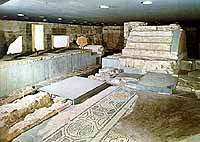
Roman remains in S. Reparata
The huge area, which has been open to the public since 1974, contains a great many remains of walls and flooring from the houses of Roman "Florentia", proof that the basilican complex (including the Baptistery) was built directly on top of the Roman strata and only six metres away from the north eastern limits of the city walls, in a popular and "working class" quarter, shown by the presence of some craft workshops.
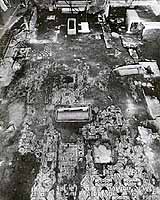
Mosaic paving of the first church
These buildings were knocked down to make room for the new cathedral halfway between the 4th and 5th century, when the city was enjoying a period of great wealth, and perhaps after encouragement from Bishop Zanobus, who died in 429. Legend tells us that the city decided to build it after Stilicho's victory over Radagaiso's barbarians, which took place on October 8th 405 in the hills behind Fiesole and was accompanied by the miraculous apparition of Santa Reparata, on the anniversary of her martyrdom.
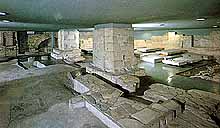
Carolingian alterations
It is known that this first church's splendid mosaic flooring, now visible
again, was placed only 30 centimetres above the paving of the Roman houses
and that its facade was eight metres closer to the Baptistery than the present
building. The interior was formed of three naves, divided by columns, with
a single semicircular apse. A memorial slab bearing the names of the 14
deacons (all of Latin origin) who financed its construction can still be
seen on the floor. The Gothic-Byzantine war that followed (535-553) was
ruinous for Florence, for it was forced to reduce the diameter of the city
walls and leave the basilica outside.
The cathedral was probably sacked and perhaps devastated. This explains its reconstruction
in the Carolingian period (8th-9th century), a fact that was discovered during
the excavation campaign. This second Santa Reparata followed the same dimensions
and three nave design as the preceding church but with the addition of two side
chapels in the area of the apse, almost a hint of the later transept used for
the plan on a Latin cross.
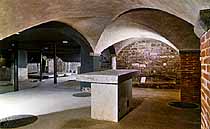
The Crypt, the altar of St. Zanobus
A sort of crypt was also added, together with new flooring created with marble inlays, marble slabs, terracotta and stone, placed only slightly above the previous mosaic. Later improvements led, among other things, to the creation of a raised chancel and a crypt like the one at San Miniato: the body of St. Zanobus, transferred from San Lorenzo in the 9th century, was kept here until 1439, when Ghiberti carried out the precious urn, now in the centre chapel of the tribune. These restructurings probably date from the period between 1050-1106, when two important ecumenic Councils were held in the cathedral and two Popes, Stephen IX and Nicholas II, who died respectively in 1058 and 1063, were buried here.

Mediaeval tombstones
The last alterations to Santa Reparata date from the 12th century (some frescoes) and 13th century, when it was re-floored with simple bricks of poor quality: by this date construction had already started on Arnolfo's basilica, so that these must just have been part of the ordinary maintenance work in order to keep the basilica functioning until 1375, the year in which the closure of the nave of Santa Maria del Fiore enforced its demolishment.
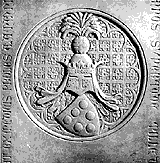
The tomb of Giovanni de' Medici
The many interesting discoveries found during excavations include a coin minted in 337-340 by the sons of Constantine the Great, a Roman mask (I B.C.-III A.D.), late Roman finds, an early Christian cup, a glass chalice of Longobard period, a 12th century gold and silver buckle, antique ceramics and majolicas and several tomb-stones, among them the grave of Niccolò Squarcialupi (1313), an ancestor of Antonio Squarcialupi whose bust, carved by Benedetto da Maiano (1490), can be seen among the sculptures in the lefthand transept of the Cathedral.

The tomb of Filippo Brunelleschi
The presence of the tomb of Giovanni di Alamanno de' Medici, who died in 1352, shows how important the family had already become at this date. Giovanni, brother of the same Salvestro who apparently led the Revolt of the Ciompi in 1378, has the prestigious office of Gonfalonier of the Republic engraved on his tombstone. The tomb of Filippo Brunelleschi was also discovered during the 1965-74 excavation campaign, though no trace has been found of the graves of Giotto and Arnolfo di Cambio who, according to tradition, were also buried here.
